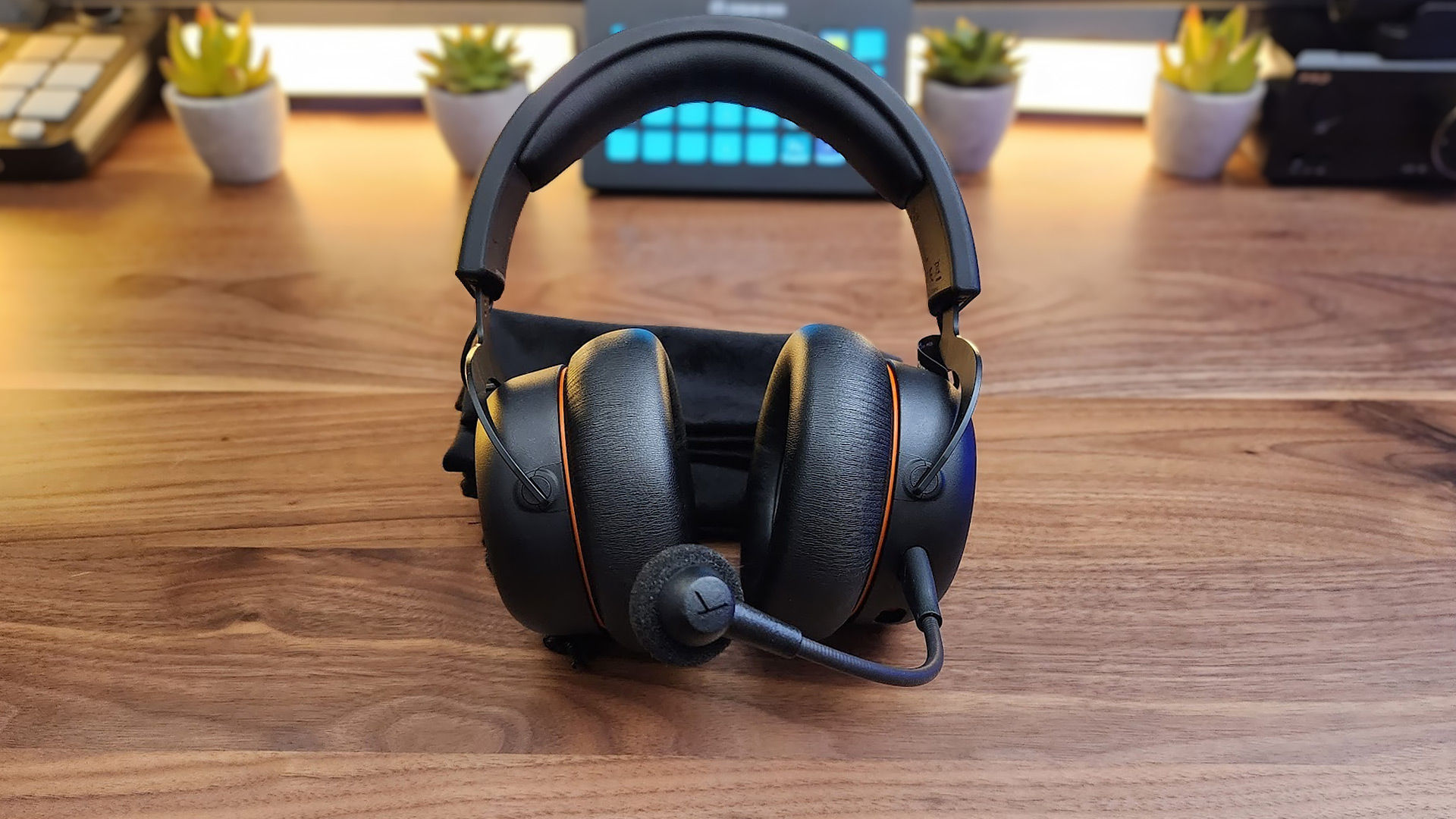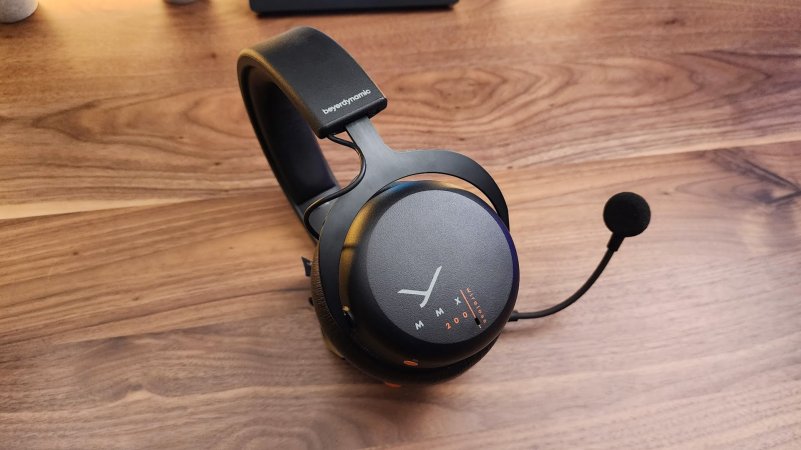

We may earn revenue from the products available on this page and participate in affiliate programs. Learn more ›
It’s no stretch to say that beyerdynamic has a great reputation inside and outside the world of gaming. Its cans regularly rank among the best headphones for audiophiles and creators. Its prior gaming headsets, the MMX 100 and MMX 300, were also regarded as some of the best picks for gamers who prioritized sound quality alongside spatial awareness. More recently, the venerable German manufacturer has introduced the MMX 200 Wireless, the company’s first wireless gaming headset, which seems to combine the ideas of previous models into something all its own (while also having a few exclusive tricks up its sleeve). At $250, it’s expensive but it offers excellent sound quality and one of the best microphones in the business, even if it lags behind the competition in some ways.
Beyerdynamic MMX 200
Overview
- The MMX 200 Wireless is beyerdynamic’s first wireless gaming headset.
- It offers two types of wireless connectivity, with 2.4GHz and Bluetooth 5.3 for instant compatibility with mobile devices, Nintendo Switch, PlayStation 5, and PC.
- Sound quality is excellent, with strong positional accuracy and a killer boom mic, but some of the supporting features are lacking (like simultaneous Bluetooth and 2.4GHz audio and the lack of active noise cancellation).
- Its minimalist aesthetic looks great, but it can get warm quickly.
Pros
- Very good sound isolation
- Excellent mic quality (with the boom microphone)
- Solid 35-hour battery life
- Stylish, minimalist design
- Good detail and positional accuracy, even during intense moments
Cons
- Can become uncomfortably warm
- Dual-mode wireless isn’t simultaneous Bluetooth and 2.4GHz audio
- No active noise cancellation
- Can feel a bit light on bass
The verdict: The beyerdynamic MMX 200 Wireless is missing some features we would have liked to see at this price point, but its sound quality and mic live up to the company’s standard of excellence.
The build
Beyerdynamic has spent years developing the iconic look of its headphones. The clean lines, clear circles, and minimalist yet refined aesthetic all carry through to the MMX 200 Wireless. If you’re familiar enough with the world of headphones to recognize a DT 770 or DT 990 or Pro X, you’ll immediately see the similarity here and recognize these as coming from the audio giant.
Even if you’re not, there’s a lot to love about how this headset is constructed. It’s not garish or overstated like many gaming headsets. It’s largely matte black but is tastefully accented with the company’s classic gray and orange. Each closed-back earcup is stamped with the company logo and product name and would border on busy if it wasn’t so sleekly integrated. The text is mixed gray and orange, and its two buttons and volume knob, split between the left and right sides, are also bright orange. Gaming peripherals tend to get stereotyped by their aggressive designs and RGB lights, but the MMX 200 lacks all but a single indicator light around the charging port and looks all the more stylish for it.
The construction is robust and feels quite sturdy. The yokes and adjustment band are made of metal. The earcups are plastic but solid and have a textured finish that avoids fingerprints. Both the headband and ear cushions are trimmer in leatherette with memory foam padding around the ears. The grip force is quite tight, so it stays locked around your ears and creates a tight, isolating seal. However, that pressure can be a bit fatiguing and become uncomfortably warm in less than an hour. This isn’t a gaming headset designed for warmer climates or summers without air conditioning.

Internally, the headset uses 40mm dynamic drivers that beyerdynamic states have been specially tuned for gaming. Their size is nothing out of the ordinary for gaming headsets, but they offer a brighter, more detail-rich sound signature than typical gaming headsets, including competitors like the Turtle Beach Stealth Pro Wireless. The MMX 200’s frequency response range isn’t as expansive as the Stealth Pro (10Hz – 22kHz) or the Steelseries Arctis Nova Pro Wireless (10Hz – 40kHz), but it covers the range of human hearing (20Hz – 20kHz) and isn’t any audibly worse for its more limited range.
Two different forms of microphone accompany its driver system. The main “META VOICE” mic mounts with a detachable gooseneck so it can be removed and repositioned as needed, and is quite good thanks to its large 9.9mm cardioid condenser capsule and its own wide frequency response: 50Hz – 18kHz, while the average gaming headset is roughly 100Hz – 10kHz. Unplugging it immediately activates two more microphones hidden in each earcup, allowing you to take them on the go without making it obvious you’re wearing a gaming headset out of the house.
That’s a real possibility thanks to its dual-mode wireless connectivity. For gaming, it comes with a USB Type-C dongle that supports low-latency 2.4GHz wireless audio. This also provides instant compatibility with gaming PCs, Nintendo Switch, and Sony PlayStation 5. For music and calls, there’s Bluetooth 5.3. These connections are not simultaneous, like its competitors, which means it’s not possible to hear both at the same time or for a call to interrupt your game. Swapping connections is fast using the provided button, but having to choose one or the other is a pretty major drawback.
Theoretically, it’s possible to work around this limitation by putting the headset into Hybrid Mode. This requires using a Jack Cable (a beyerdynamic-branded USB Type-C-to-3.5mm) that isn’t included with the headset and, as of this writing, isn’t available for purchase. Given its high cost, it’s rather egregious that this wasn’t included in the box. While the headset can be used wired with a standard USB Type-C, swapping to Bluetooth immediately disconnects the headset from a PC.

It’s clear that beyerdynamic has tried to make the MMX 200 feature-rich to justify its high price point. In addition to using the latest Bluetooth version, automatic microphone switching, and dual-mode wireless, it features a transparency mode that allows you to hear the world around you. Holding the mute button activates the two microphones built into each earcup. It’s great for quick conversations or when you’re waiting for guests to knock at your door.
There are also missing features, like its lack of active noise cancelation. This is becoming a more common feature on high-end gaming headsets (both the Stealth Pro and Nova Pro include it) and is another disappointing omission that makes the MMX 200 feel less competitive. There’s no software or app support for custom EQ settings or virtual surround sound. There’s also no game-chat mix to help you balance out the sound of your teammates to the sound of your game.
Another critical point is battery life; thankfully, the headset is out to impress. It’s rated for 35 hours, which is nearly triple that of the Turtle Beach Stealth Pro Wireless and 10 hours greater than the Steelseries Arctis Nova Pro Wireless. In my testing, it lasted roughly 32 hours, so you can safely count on a week or more between recharges.
The sound
If there’s one area where the MMX 200 should reign supreme, it’s sound quality. Beyerdynamic has a long track record of delivering great-sounding, purpose-driven headphones and gaming headsets, and the MMX 200 continues that trend. It even evolves it with one of the best-sounding microphones you’ll find in a gaming headset.
One of the quirks of the gaming headset industry (of headphones in general) is that headsets often sound more balanced the more expensive they get. Low- to mid-cost headsets frequently over-emphasize the bass to create an energized listening experience with “cinematic” rumble. As prices stretch above $150 and into enthusiast territory, the bass tends to scale back a bit; mids and highs become more important. On the best gaming headsets, virtual surround sound transitions from a necessity to an optional feature as the drivers themselves render spatial details more accurately without the intervention of digital processing (though Atmos and EQ are available if you want to pay for a subscription to Dolby software). This is the experience of the MMX 200.

Yet, even compared to impressive stalwarts like the Nova Pro Wireless, the MMX 200 is noticeably more balanced and detailed. There’s just enough bass to feel full; beyerdynamic fans will notice that there’s more than the average pair of audiophile cans from the company but not enough to sound bloated. In fact, gamers coming from a more traditional gaming headset, like the Razer Blackshark V2 Pro, may even find them a bit lean at first. What it trades in bass power, it makes up for in detail and clarity.
In these areas, the headset is actually much closer to the company’s audiophile headphones. While not spacious, it provides clear separation between every layer of sound and complements it with excellent stereo imaging. The tuning emphasizes important details, like footsteps and teammate callouts, allowing them to come through above even cacophonous torrents of sound.
This is a headset that lends you an edge. Playing through rounds of Call of Duty: Modern Warfare 3, I was able to hear enemies before I would see them turn a corner. More than once, I got the jump on a flanking enemy purely because of the MMX 200’s excellent layering and clarity.

The downside is that the same frequencies that make directional cues jump to the forefront can also make them slightly fatiguing. They’re not sharp or sibilant, but after a couple of hours of gaming, my ears were ready for a break.
For music and movies, it’s also enjoyable, though bass fiends may want to stick to games. Acoustic tracks, like Matt Hansen’s “Break My Bones” or Lord Huron’s “The Night We Met” play to the headset’s strengths, but metal and hip-hop lacked the low-end power to do those genres justice. It’s not anemic and not unenjoyable, but it’s here that a software-based EQ would be helpful.
Returning to its high points, the detachable microphone is genuinely one of the best available among wireless gaming headsets. Its extended frequency response and larger capsule allow it to capture a wider range of frequencies and deliver a deeper, fuller, and much more natural capture. There’s a modest amount of noise cancellation that can reduce the volume of PC fans and peripherals, and while it doesn’t totally silence them, it also doesn’t create the nasally compressed sound of most noise-canceling microphones. While the hidden mics within each ear cup are bog standard for wireless headphones (distant and slightly muffled), the boom microphone is excellent and a prime contender for streamers and content creators looking for an all-in-one solution.

The conclusion
The MMX 200’s stellar sonics and killer comms go a long way to make up for its missing features but don’t fully make it the definitive choice. Its biggest competitor, the Turtle Beach Stealth Pro Wireless, offers a significantly richer feature set, including swappable batteries and app support. Yet, for that, the MMX 200 is cheaper and sounds better overall, even without an app. Beyerdynamic does a lot right here, but I wish it had gone just a little farther with its gaming qualities. You’ll need to weigh price and features over acoustics to decide if it’s the best choice for you, but on its own merits, the beyerdynamic MMX 200 Wireless is a great gaming headset that can offer a competitive edge and a fun listening experience.

